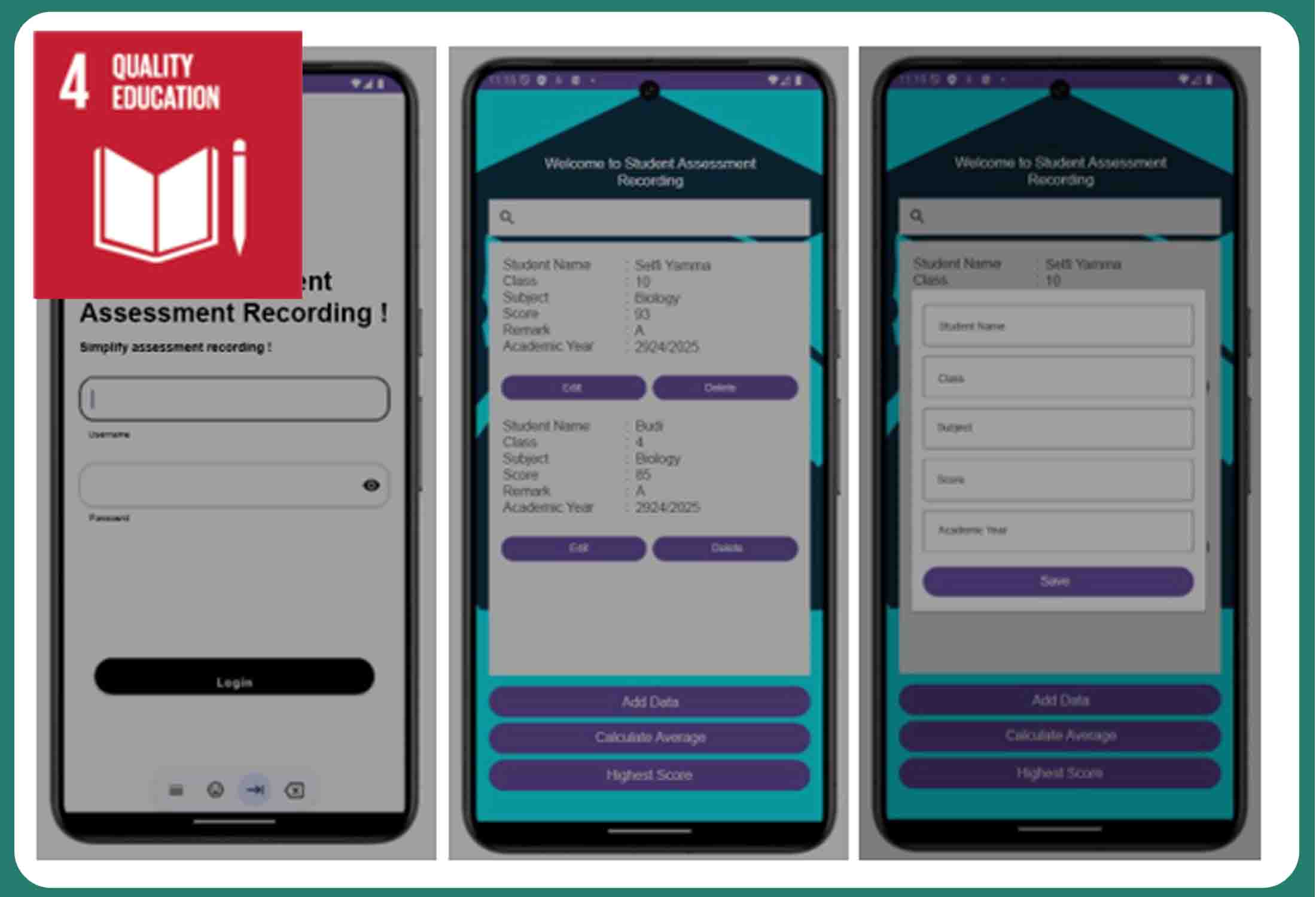Evaluation of Android-Based Mobile Application for Student Grade Management at SMKN 1 Payakumbuh
DOI:
https://doi.org/10.24036/javit.v5i3.270Keywords:
Mobile application, Android, Teacher evaluation, Practicality, Grade management, EffectivenessAbstract
Teachers play an essential role in conducting learning assessments; however, manual grade recording remains a challenge due to high administrative workloads and time constraints. These limitations often lead to inaccuracies and delays in academic data processing. Therefore, this study aimed to evaluate the practicality and effectiveness of an Android-based grade management application designed to support teachers in administering student assessments more efficiently. The research was conducted at SMK Negeri 1 Payakumbuh involving two practitioners and twenty subject teachers as respondents. Practicality data were collected through a questionnaire consisting of three assessed aspects: ease of use, flexibility, and features and functionality. The results showed that the application achieved an average practicality score of 89.17% based on practitioners’ responses and 84.50% based on subject teachers’ responses, both of which fall into the “very practical” category. These findings indicate that the application is easy to operate, accessible, and supportive of mobile-based administrative tasks. Furthermore, effectiveness was tested by comparing post-test results between a control group (manual grade entry) and an experimental group (using the application). Statistical analysis using an independent samples t-test demonstrated a significant difference in performance (p = 0.000 < 0.05), with the experimental group achieving a higher average score of 77.8 compared to 65.5 in the control group. This confirms that the Android-based application improves accuracy and efficiency in grade processing. In conclusion, the developed grade management application is both practical and effective, and it has strong potential to assist teachers in simplifying assessment administration through a fast, accurate.
Downloads
References
R. N. Okafor and E. O. Ekwulu, “Utilization of Education Management Information System (Emis) for School Social Work and Administration: Emerging Issues and Solutions,” J. Theor. Empir. Stud. Educ., vol. 10, no. 1, pp. 235–254, Apr. 2025.
A. A. Adeleke, N. O. Orunbon, A. Shahid, F. Mowafaq, M. D. Lee, and A. Majid, “Revolutionizing Education Harnessing Technology For Efficient School Management.,” Libr. Progress-Library Sci. Inf. Technol. & Comput., vol. 44, no. 3, pp. 21913–21934, Jul. 2024, Accessed: Oct. 30, 2025. [Online]. Available: https://research.ebsco.com/linkprocessor/plink?id=942049ea-05cb-3986-a9b1-3c26055c5052.
M. K. Budiarto, T. Rejekiningsih, and S. Sudiyanto, “Students’ opinions on the need for interactive multimedia development for entrepreneurship learning,” Int. J. Eval. Res. Educ., vol. 10, no. 4, pp. 1290–1297, Dec. 2021, https://doi.org/10.11591/ijere.v10i4.21411.
A. Barlybayev et al., “Сomparative Analysis of Grading Models Using Fuzzy Logic To Enhance Fairness and Consistency in Student Performance Evaluation,” Cogent Educ., vol. 12, no. 1, 2025, https://doi.org/10.1080/2331186X.2025.2481008.
E. Susanti, A. Hikmat, and W. Tarmini, “Needs analysis fo the development of web-based teaching materials in scientific writing skills instruction for eleventh-grade vocational high school students,” J. Ilmu Bhs. dan Sastra, vol. 45, no. 2, pp. 222–231, Jun. 2025, https://doi.org/10.26555/BS.V45I2.1407.
I. Adimas et al., “Integrating Video Barcode Technology In Multimedia Spreadsheet Textbooks: A Modern Approach To Teaching Corporate Financial Statements,” Int. J. Humanit. Adv. Bus. Sci., vol. 3, no. 1.1, pp. 177–194, Jun. 2025, https://doi.org/10.59971/IJHABS.V3I1.1.624.
S. Ahmed Langove and A. Khan, “Automated Grading and Feedback Systems: Reducing Teacher Workload and Improving Student Performance,” J. Asian Dev. Stud., vol. 13, no. 4, pp. 202–212, Dec. 2024, https://doi.org/10.62345/jads.2024.13.4.16.
G. Ali, D. Asiku, M. M. Mijwil, I. Adamopoulos, and M. Dudek, “Fusion of Blockchain, IoT, Artificial Intelligence, and Robotics for Efficient Waste Management in Smart Cities,” Int. J. Innov. Technol. Interdiscip. Sci., vol. 8, no. 3, pp. 388–495, Sep. 2025, https://doi.org/10.15157/IJITIS.2025.8.3.388-495.
J. J. Liu, H. Wu, and I. Riaz, “Advanced Technologies for Smart Fertilizer Management in Agriculture: A Review,” IEEE Access, vol. 13, pp. 139766–139790, 2025, https://doi.org/10.1109/ACCESS.2025.3594361.
Prof.Mr.Rahul.D.Dhongade, Aditi Dhotre, Vaishnavi Chaugule, Sufiya Mahat, and Anushka Salunkhe, “SmartCampus Application: College Management System With Student Progress Tracking System” Authorea Prepr., Apr. 2025, https://doi.org/10.36227/TECHRXIV.174494911.10565237/V1.
A. I. Jamal and W. Wahira, “A Literature Review on Smart Apps Creator-Based Teacher Performance Management Model for Strengthening Supervision in Elementary Schools,” Int. J. Adm. Educ., pp. 42–53, Jun. 2025, https://doi.org/10.70188/m6evf581.
T. Liu, Y. T. Luo, P. C.-I. Pang, and H. Y. Kan, “Exploring the Impact of Information and Communication Technology on Educational Administration: A Systematic Scoping Review,” Educ. Sci., vol. 15, no. 9, p. 1114, Aug. 2025, https://doi.org/10.3390/educsci15091114.
M. Suryani et al., “Role, Methodology, and Measurement of Cognitive Load in Computer Science and Information Systems Research,” IEEE Access, vol. 12, pp. 190007–190024, 2024, https://doi.org/10.1109/ACCESS.2024.3514355.
S. Sahni, S. Verma, and R. P. S. Kaurav, “Understanding digital transformation challenges for online learning and teaching in higher education institutions: a review and research framework,” Benchmarking, vol. 32, no. 5, pp. 1487–1521, May 2024, https://doi.org/10.1108/BIJ-04-2022-0245.
L. Barik, A. A. Alrababah, and Y. D. Al-Otaibi, “Enhancing educational data mining based ICT competency among e-learning tutors using statistical classifier,” Int. J. Adv. Comput. Sci. Appl., vol. 11, no. 3, pp. 561–568, 2020, https://doi.org/10.14569/ijacsa.2020.0110371.
H. Shen, X. Ye, J. Zhang, and D. Huang, “Investigating the role of perceived emotional support in predicting learners’ well-being and engagement mediated by motivation from a self-determination theory framework,” Learn. Motiv., vol. 86, p. 101968, May 2024, https://doi.org/10.1016/J.LMOT.2024.101968.
A. C. Lindholst, T. B. Eriksen, and S. V. Knudsen, “Danish school pupils’ perception of their learning outcomes from participating in computer-based adaptive tests: a pressure for just clicking something?,” Scand. J. Educ. Res., vol. 68, no. 6, pp. 1186–1202, 2023, https://doi.org/10.1080/00313831.2023.2228823.
V. Redondo-Blasco and F. Martínez-Abad, “SLR on the resilience-academic performance relationship of students in compulsory education: analysis of large-scale evaluations,” Aula Abierta, vol. 53, no. 1, pp. 37–45, 2024, https://doi.org/10.17811/rifie.20419.
H. Ateş, “Integrating augmented reality into intelligent tutoring systems to enhance science education outcomes,” Educ. Inf. Technol., vol. 30, no. 4, pp. 4435–4470, Aug. 2024, https://doi.org/10.1007/s10639-024-12970-y.
D. H. Tong, B. P. Uyen, and L. K. Ngan, “The effectiveness of blended learning on students’ academic achievement, self-study skills and learning attitudes: A quasi-experiment study in teaching the conventions for coordinates in the plane,” Heliyon, vol. 8, no. 12, p. e12657, Dec. 2022, https://doi.org/10.1016/j.heliyon.2022.e12657.
D. Alt and N. Raichel, “Enhancing perceived digital literacy skills and creative self-concept through gamified learning environments: Insights from a longitudinal study,” Int. J. Educ. Res., vol. 101, no. January, p. 101561, 2020, https://doi.org/10.1016/j.ijer.2020.101561.
S. Agustin, Hanesman, Efrizon, and H. Hidayat, “The Effect of Problem Based Learning Model with Focus Group Discussion Method on Students’ Learning Outcomes in Basic Vocational Subjects at SMK Negeri 1 Sumatera Barat,” J. Hypermedia Technol. Learn., vol. 2, no. 3, pp. 202–213, Jun. 2024, https://doi.org/10.58536/j-hytel.v2i3.135.
Y. Kaya, G. Ebru, B. Kırlangıç-Şimşek, and M. Cesur-Atintaş, “The effect of psychodrama group practices on nursing students’ self-liking, self-competence, and self-acceptance: A quasi-experimental study,” Perspect. Psychiatr. Care, vol. 58, no. 4, pp. 1239–1247, Oct. 2022, https://doi.org/10.1111/ppc.12921.
A. Gurses, C. Dogar, and K. Gunes, “A New Approach for Learning: Interactive Direct Teaching Based Constructivist Learning (IDTBCL),” Procedia - Soc. Behav. Sci., vol. 197, no. February, pp. 2384–2389, 2015, https://doi.org/10.1016/j.sbspro.2015.07.296.
H. S. Rad, A. Roohani, and M. R. Domakani, “Flipping EFL learners’ writing classroom through role-reversal and discussion-oriented models,” Language Learning and Technology, vol. 25, no. 2. University of Hawaii National Foreign Language Resource Center, pp. 158–177, Jun. 01, 2021. Accessed: Mar. 24, 2025. [Online]. Available: http://hdl.handle.net/10125/73438.
F. G. Karaoglan Yilmaz, “Utilizing Learning Analytics to Support Students’ Academic Self-efficacy and Problem-Solving Skills,” Asia-Pacific Educ. Res., vol. 31, no. 2, pp. 175–191, Apr. 2022, https://doi.org/10.1007/s40299-020-00548-4.
R. M. McFee, A. S. Cupp, and J. R. Wood, “Use of case-based or hands-on laboratory exercises with physiology lectures improves knowledge retention, but veterinary medicine students prefer case-based activities,” Adv. Physiol. Educ., vol. 42, no. 2, pp. 182–191, Jun. 2018, https://doi.org/10.1152/advan.00084.2017.
A. Marini, D. Safitri, A. Niladini, M. Zahari, L. Dewiyani, and U. Muawanah, “Developing a website integrated with project-based learning: Evidence of stimulating creativity among elementary school students in Indonesia,” Soc. Sci. Humanit. Open, vol. 11, p. 101402, Jan. 2025, https://doi.org/10.1016/j.ssaho.2025.101402.
R. A. G. Pierri, M. R. Oliveira, G. Trento, R. Spin-Neto, M. M. Rodrigues, and V. A. Pereira-Filho, “Evaluation of Daytime Sleepiness and Academic Performance in Dentistry Students,” Eur. J. Gen. Dent., vol. 10, no. 1, pp. 37–43, 2021, https://doi.org/10.1055/s-0041-1732772.
N. Smits, O. Öğreden, M. Garnier-Villarreal, C. B. Terwee, and R. P. Chalmers, “A study of alternative approaches to non-normal latent trait distributions in item response theory models used for health outcome measurement,” Stat. Methods Med. Res., vol. 29, no. 4, pp. 1030–1048, 2020, https://doi.org/10.1177/0962280220907625.
S. Prayogi and N. N. S. P. Verawati, “The effect of conflict cognitive strategy in inquiry-based learning on preservice teachers’ critical thinking ability,” J. Educ. Cult. Psychol. Stud., vol. 2020, no. 21, pp. 27–41, Jun. 2020, https://doi.org/10.7358/ecps-2020-021-pray.
Junita, Yerizon, A. Asmar, and R. Rifandi, “Development of learning devices based on integrated multiple intelligences skills 4C in achieving competency of class VIII SMP/MTs students,” AIP Conference Proceedings, vol. 2698. 2023. https://doi.org/10.1063/5.0122482.
R. Ariyanto, B. Haryadi, M. Harlanu, J. H. Kiai Wahid Hasyim NoKm, and K. Bancak, “Development of Competency Test for Cluster Scheme of Information System-Based Network Cable Installation,” J. Vocat. Career Educ., vol. 7, no. 1, pp. 39–46, Jul. 2022, https://doi.org/10.15294/JVCE.V6I2.38122.
E. Syahmaidi, H. Hidayat, S. Hartanto, and A. F. Rahmadani, “Needs analysis of designing online computer-assisted training to improve pedagogical competencies in engineering education,” Int. J. Eng. Adv. Technol., vol. 8, no. 6, pp. 4619–4624, 2019, https://doi.org/10.35940/ijeat.F8905.088619.
E. Abad-Segura, F. J. Castillo-Díaz, A. Batlles-delaFuente, and L. J. Belmonte-Ureña, “The Impact of Sustainable Technologies on Business Strategy and Competitiveness,” Environ. Footprints Eco-Design Prod. Process., vol. Part F120, pp. 103–130, 2025, https://doi.org/10.1007/978-3-031-81029-9_6.
R. Rahayu, Sutikno, and D. R. Indriyanti, “Ethnosains Based Project Based Learning Model with Flipped Classroom on Creative Thinking Skills,” J. Penelit. Pendidik. IPA, vol. 9, no. 8, pp. 348–355, Aug. 2023, https://doi.org/10.29303/jppipa.v9i8.3051.
C. Rodríguez-Abad, R. Rodríguez-González, A. E. Martínez-Santos, and J. del C. Fernández-de-la-Iglesia, “Effectiveness of augmented reality in learning about leg ulcer care: A quasi-experimental study in nursing students,” Nurse Educ. Today, vol. 119, p. 105565, Dec. 2022, https://doi.org/10.1016/j.nedt.2022.105565.
A. Abusamra, K. Muhtaseb, and R. Awawdeh, “How should E-learning be conceptualized in the context of higher education in MENA region?,” Soc. Sci. Humanit. Open, vol. 12, 2025, https://doi.org/10.1016/j.ssaho.2025.101808.
A. D. Samala et al., “Unveiling the landscape of generative artificial intelligence in education: a comprehensive taxonomy of applications, challenges, and future prospects,” Educ. Inf. Technol., Feb. 2024, https://doi.org/10.1007/s10639-024-12936-0.
J. J. Watters, H. K. Pillay, and M. Flynn, “Industry-School Partnership: A strategy to enhance education and training opportunities,” no. October, p. 18, 2016.
N. S. Lestari, F. Hanurawan, O. A. Suciptaningsih, and N. I. I. Itsnain, “Psychological Characteristics of Personality in Elementary School-Aged Children in Indonesia: Review and Implications,” Edukasi Islam. J. Pendidik. Islam, vol. 13, no. 04, pp. 729–744, Nov. 2024, https://doi.org/10.30868/EI.V13I04.6636.
V. J. Owan, K. B. Abang, D. O. Idika, E. O. Etta, and B. A. Bassey, “Exploring the potential of artificial intelligence tools in educational measurement and assessment,” Eurasia J. Math. Sci. Technol. Educ., vol. 19, no. 8, p. em2307, Aug. 2023, https://doi.org/10.29333/ejmste/13428.
A. Alam, “Should Robots Replace Teachers? Mobilisation of AI and Learning Analytics in Education,” 2021 7th IEEE Int. Conf. Adv. Comput. Commun. Control. ICAC3 2021, 2021, https://doi.org/10.1109/ICAC353642.2021.9697300.

Downloads
Published
How to Cite
Issue
Section
License
Copyright (c) 2025 Rince Tridiana

This work is licensed under a Creative Commons Attribution 4.0 International License.










